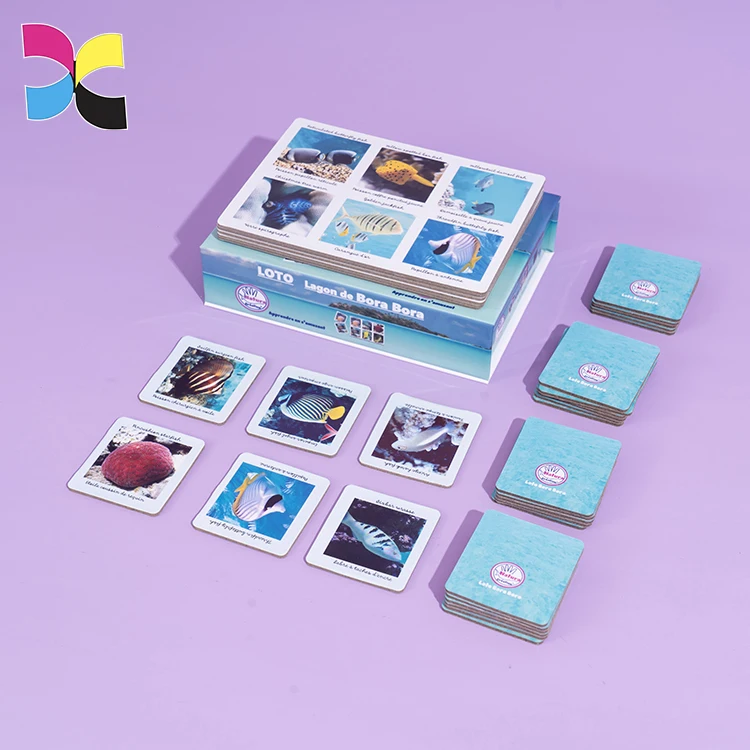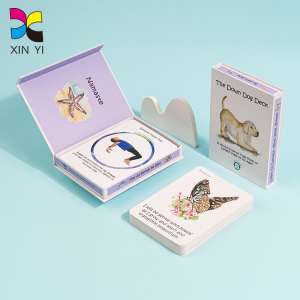Introduction
Custom game card printing refers to the process of creating personalized playing cards for various purposes such as board games, trading card games, educational tools, promotional items, and more. Unlike mass-produced standard playing cards, custom game card printing allows individuals or businesses to design and produce cards tailored to specific themes, designs, and purposes.
The importance of quality materials in custom game card printing cannot be overstated, as it directly influences the overall aesthetic appeal, durability, and user experience of the cards.Investing in quality materials is a crucial aspect of ensuring the success and longevity of any game.
Understanding Quality Materials
In the context of custom game card printing, quality materials include high-grade paper stocks, superior printing inks, protective coatings, and other components that ensure the cards meet the desired standards of appearance, durability, and tactile experience.
Here are the types of materials commonly used in custom game card printing:
1.Paper Stock Options:
- Standard Cardstock: This is the most common choice for game cards. It offers a balance between cost and quality. Cardstock comes in various weights, typically measured in GSM (grams per square meter), with heavier weights offering greater durability.
- Premium Cardstock: For higher-quality games, premium cardstock options are available, often with smoother finishes and higher GSM. These cards feel more luxurious and may have better durability.
- Linen Finish Cardstock: Some cardstock options come with a linen finish, which adds texture to the cards and can enhance their aesthetic appeal.
2.Coating and finishing options
- Glossy Finish: A glossy coating adds shine to the cards and makes colors appear more vibrant. It also provides some level of protection against moisture and wear.
- Matte Finish: Matte coatings give cards a non-reflective, velvety surface. They can reduce glare and offer a more sophisticated look, although they may not be as resistant to scratches and scuffs as glossy finishes.
- UV Coating: UV coating provides a high-gloss, durable finish that offers excellent protection against wear and tear. It’s a popular choice for game cards that will be handled frequently.
- Lamination: Lamination involves applying a thin layer of plastic film to the cards, providing strong protection against moisture, bending, and tearing. It can come in gloss or matte varieties.
3.Durability considerations
- Thickness: Thicker cardstock typically offers better durability, as it’s less prone to bending or creasing.
- Water Resistance: Some coatings and laminations provide water resistance, protecting the cards from spills or moisture damage.
- Edge Treatment: Rounded corners or beveled edges can reduce the likelihood of cards getting damaged from frequent handling.
- Tear Resistance: Higher-quality cardstock and coatings can improve tear resistance, ensuring that the cards hold up well over time.
When choosing materials for custom game card printing, it’s essential to consider factors such as budget, intended use, and desired aesthetic appeal. Each option has its own advantages and considerations, so it’s worth exploring different combinations to find the best fit for your specific project.
Enhancing Gameplay Experience
1.Factors Affecting Gameplay with Regards to Card Quality:
Durability: High-quality materials like thick cardstock and protective coatings ensure that game cards withstand frequent handling, shuffling, and gameplay without getting damaged. Durable cards maintain their structural integrity, preventing wear and tear that could impact gameplay.
Print Clarity: Clear, sharp printing ensures that game card text and graphics are legible, preventing confusion during gameplay. High-resolution printing and quality materials contribute to print clarity, making it easier for players to read and interpret card content.
Texture and Feel: The tactile experience of handling game cards can influence gameplay enjoyment. Smooth, well-finished cards with a pleasing texture enhance the overall feel of gameplay, making it more immersive and enjoyable for players.
Consistency: Uniformity in card size, thickness, and print quality across all cards in a game set ensures a consistent gameplay experience. Consistent card quality prevents discrepancies that could affect game balance or fairness.
2.Player Satisfaction and Engagement:
High-quality game cards contribute to player satisfaction and engagement by enhancing the overall gaming experience. Players are more likely to enjoy a game when the components, including cards, look and feel premium.
Well-designed and durable cards can increase player immersion in the game world, fostering a deeper connection with the gameplay mechanics, theme, and narrative.
Players appreciate the attention to detail and craftsmanship that goes into high-quality game components, leading to greater overall satisfaction and enjoyment.
3.Longevity of Game Cards:
Quality materials and construction contribute to the longevity of game cards, ensuring that they remain playable for an extended period. Durable cards resist damage from handling, spills, and general wear and tear, maintaining their appearance and functionality over time.
Games with long-lasting cards offer better value for players, as they can be enjoyed repeatedly without the need for frequent replacement or repair. Longevity adds to the overall appeal of a game and encourages players to return to it time and again.
Economic Considerations
Considering economic factors in custom game card printing is essential for both producers and consumers.
1.Initial investment vs. long-term cost-effectiveness
Initial Investment: High-quality materials and printing techniques often come with a higher upfront cost. This includes using premium cardstock, specialized coatings, and advanced printing processes. However, this initial investment is crucial for creating a superior product.
Long-term Cost-effectiveness: Despite the higher initial investment, using quality materials and printing methods can lead to long-term cost-effectiveness. Durable cards are less likely to get damaged, reducing the need for replacements. Additionally, satisfied customers are more likely to recommend the game to others, leading to increased sales over time.
2.Value proposition for customers
Perceived Value: Customers are willing to pay more for a product that they perceive as high-quality. Investing in premium materials and printing techniques enhances the perceived value of the game cards, making customers feel like they’re getting their money’s worth.
Enhanced Gameplay Experience: High-quality game cards contribute to a better overall gaming experience. Customers value components that are durable, visually appealing, and enjoyable to use. A positive gameplay experience increases the perceived value of the game as a whole.
3.Impact on brand reputation and repeat business
Brand Reputation: Producing games with high-quality components, including game cards, enhances the reputation of the brand. Customers associate the brand with quality and reliability, which can lead to increased trust and loyalty.
Repeat Business: Satisfied customers are more likely to become repeat customers. Investing in quality game cards not only leads to initial sales but also encourages customers to purchase future products from the same brand. Positive word-of-mouth recommendations further contribute to repeat business.
Sustainability and Environmental Impact
When considering sustainability and environmental impact in custom game card printing, it’s crucial to explore eco-friendly material options and recycling/disposal considerations:
1.Eco-friendly material options
Recycled Paper: Using paper made from recycled materials reduces the demand for virgin pulp and minimizes waste. Look for options with high post-consumer recycled content to maximize environmental benefits.
FSC-Certified Paper: Forest Stewardship Council (FSC) certification ensures that the paper comes from responsibly managed forests, promoting sustainable forestry practices.
Alternative Fiber Sources: Explore materials made from alternative fiber sources such as bamboo, hemp, or agricultural residues. These materials often have lower environmental impacts compared to traditional wood pulp.
Chlorine-Free Bleaching: Opt for paper that has been bleached using chlorine-free processes to minimize harmful chemical pollution.
2.Recycling and disposal considerations
Recyclability: Choose materials that are easily recyclable at the end of their life cycle. This includes paper products that can be recycled through standard municipal recycling programs.
Biodegradability: Materials that are biodegradable break down naturally over time, reducing their impact on landfills. Look for options that are certified as biodegradable or compostable.
Consideration of Coatings and Finishes: Some coatings and finishes, such as certain types of laminations or glossy coatings, can make recycling more challenging. Opt for coatings that are compatible with recycling processes or choose finishes that can be easily removed before recycling.
Educational Resources: Provide information to consumers about how to properly dispose of game cards at the end of their life cycle. This may include instructions on recycling or composting, as well as alternative disposal methods if recycling is not feasible.
By selecting eco-friendly material options and considering recycling and disposal considerations, custom game card printing can minimize its environmental impact and promote sustainability throughout the product lifecycle.
Conclusion
Quality materials are essential for custom game card printing,Designers and manufacturers should prioritize the selection of quality materials for custom game card printing to deliver superior products to consumers,offer a premium gaming experience, leading to increased customer satisfaction, engagement, and loyalty.Furthermore, designers and manufacturers should collaborate closely to innovate and explore new material options that balance quality, sustainability, and cost-effectiveness.
Ready to elevate your game? Get started with custom card printing today and bring your vision to life. From design to delivery, we’ll ensure your cards stand out with quality craftsmanship and attention to detail. Let’s create something unforgettable together.


